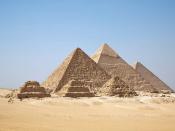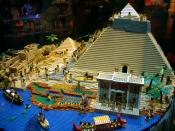EGYPTIAN MUMMIES
Ancient Egyptians had strong beliefs about their dead, and they were obsessed with the afterlife and the requirement to preserve their dead. The Egyptians developed mummification for preserving their dead.
At least nine steps were involved in the making of a mummy. It usually took about seventy days before mummification was completed.
The first step was to remove the internal organs. These organs are usually the first to decay. Embalmers used a rod to take out the brain tissue through the nose. They did not save the brain; however, they did preserve the heart. They believed thoughts came from the heart and not the brain. Embalmers also took out the stomach, liver, and intestines through a cut in the side.
In the second step, the body was washed with wine. The alcohol in the wine was used to kill the bacteria. The body was then stuffed with cloth or other kinds of material to help it dry and keep its shape.
In the third step, the lungs, stomach, liver and intestines were washed, dried, and covered with resin. They were then wrapped with linen and put in canopic jars. These jars were then placed with the mummy.
The fourth step was to complete the drying of the body. Embalmers packed the body with natron, which is sodium carbonate hydrate, a mineral. Embalmers covered the body with natron for forty days.
In the fifth step the stuffing was taken out and replaced with new linen and small bags filled with natron, earth, or herbs. The cut on the side was closed and linen pads or jewels were put over the eyes. Oil, perfume, and spices were rubbed on the skin.
In the sixth step, the body was smeared with warm resin. Resin is a viscous liquid substance made from...


